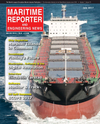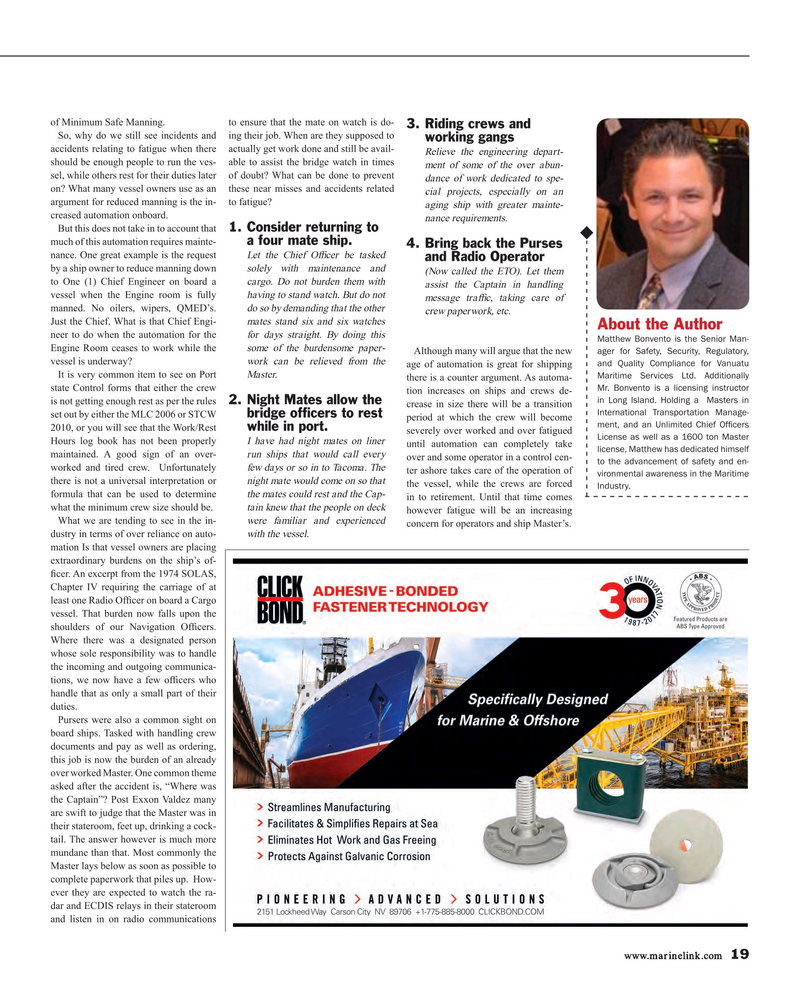
Page 19: of Maritime Reporter Magazine (July 2017)
The Marine Communications Edition
Read this page in Pdf, Flash or Html5 edition of July 2017 Maritime Reporter Magazine
of Minimum Safe Manning. to ensure that the mate on watch is do- 3. Riding crews and
So, why do we still see incidents and ing their job. When are they supposed to working gangs accidents relating to fatigue when there actually get work done and still be avail-
Relieve the engineering depart- should be enough people to run the ves- able to assist the bridge watch in times ment of some of the over abun- sel, while others rest for their duties later of doubt? What can be done to prevent dance of work dedicated to spe- on? What many vessel owners use as an these near misses and accidents related cial projects, especially on an argument for reduced manning is the in- to fatigue?
aging ship with greater mainte- creased automation onboard. nance requirements.
But this does not take in to account that 1. Consider returning to much of this automation requires mainte- a four mate ship. 4. Bring back the Purses nance. One great example is the request Let the Chief Of? cer be tasked and Radio Operator by a ship owner to reduce manning down solely with maintenance and (Now called the ETO). Let them to One (1) Chief Engineer on board a cargo. Do not burden them with assist the Captain in handling vessel when the Engine room is fully having to stand watch. But do not message traf? c, taking care of manned. No oilers, wipers, QMED’s. do so by demanding that the other crew paperwork, etc.
Just the Chief. What is that Chief Engi- mates stand six and six watches
About the Author neer to do when the automation for the for days straight. By doing this
Matthew Bonvento is the Senior Man-
Engine Room ceases to work while the some of the burdensome paper- ager for Safety, Security, Regulatory,
Although many will argue that the new vessel is underway? work can be relieved from the and Quality Compliance for Vanuatu age of automation is great for shipping
It is very common item to see on Port Master.
Maritime Services Ltd. Additionally there is a counter argument. As automa-
Mr. Bonvento is a licensing instructor state Control forms that either the crew tion increases on ships and crews de- in Long Island. Holding a Masters in 2. Night Mates allow the is not getting enough rest as per the rules crease in size there will be a transition
International Transportation Manage- set out by either the MLC 2006 or STCW bridge of? cers to rest period at which the crew will become ment, and an Unlimited Chief Of? cers 2010, or you will see that the Work/Rest while in port. severely over worked and over fatigued
License as well as a 1600 ton Master
Hours log book has not been properly I have had night mates on liner until automation can completely take license, Matthew has dedicated himself maintained. A good sign of an over- run ships that would call every over and some operator in a control cen- to the advancement of safety and en- worked and tired crew. Unfortunately few days or so in to Tacoma. The ter ashore takes care of the operation of vironmental awareness in the Maritime there is not a universal interpretation or night mate would come on so that the vessel, while the crews are forced
Industry.
formula that can be used to determine the mates could rest and the Cap- in to retirement. Until that time comes what the minimum crew size should be. tain knew that the people on deck however fatigue will be an increasing
What we are tending to see in the in- were familiar and experienced concern for operators and ship Master’s.
dustry in terms of over reliance on auto- with the vessel. mation Is that vessel owners are placing extraordinary burdens on the ship’s of- ? cer. An excerpt from the 1974 SOLAS,
Chapter IV requiring the carriage of at least one Radio Of? cer on board a Cargo vessel. That burden now falls upon the shoulders of our Navigation Of? cers.
Where there was a designated person whose sole responsibility was to handle the incoming and outgoing communica- tions, we now have a few of? cers who handle that as only a small part of their duties.
Pursers were also a common sight on board ships. Tasked with handling crew documents and pay as well as ordering, this job is now the burden of an already over worked Master. One common theme asked after the accident is, “Where was the Captain”? Post Exxon Valdez many are swift to judge that the Master was in their stateroom, feet up, drinking a cock- tail. The answer however is much more mundane than that. Most commonly the
Master lays below as soon as possible to complete paperwork that piles up. How- ever they are expected to watch the ra- dar and ECDIS relays in their stateroom and listen in on radio communications www.marinelink.com 19
MR #7 (18-25).indd 19 MR #7 (18-25).indd 19 7/7/2017 9:14:30 AM7/7/2017 9:14:30 AM

 18
18

 20
20
